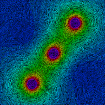This paper lays the groundwork for comparing flow visualizations using streamlines and line integral convolution (LIC). Our approach is to identify and define relevant parameters in each of these flow visualization techniques. Mapping strategies are then designed to generate LIC-like images from streamlines and streamline-like images from LIC. The result is a technique which we call pseudo-LIC or PLIC. The main contribution being reported in this paper is a methodology for flexibly generating flow visualizations that span the spectrum of streamline-like to LIC-like. Among the advantages are: performance speedups over LIC, applicability to time varying data sets, and variable-speed animation.
The audio was removed from these movies so that they are
not huge and easy to download. The movies are in the
quick-time format and were compressed using gzip.
Please use the loop mode of your movieplayer to watch these movies.
All animations are pseudo-colored with the velocity magnitude.
Animation of steady flow:
Unsteady flow for the Dynamic Vortices dataset:
 Enhanced-LIC [19.8Mb]
Enhanced-LIC [19.8Mb]
Movie notes
 Enhanced-LIC (without pseudo-coloring)[8.2Mb]
Enhanced-LIC (without pseudo-coloring)[8.2Mb]
Movie notes
 UFLIC (without pseudo-coloring)[6.8Mb]
UFLIC (without pseudo-coloring)[6.8Mb]